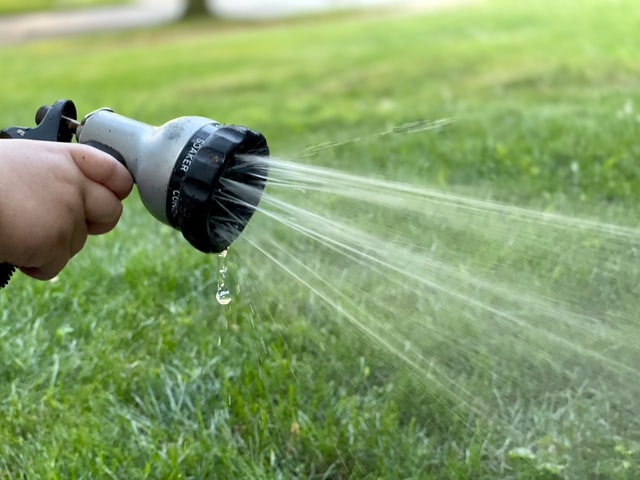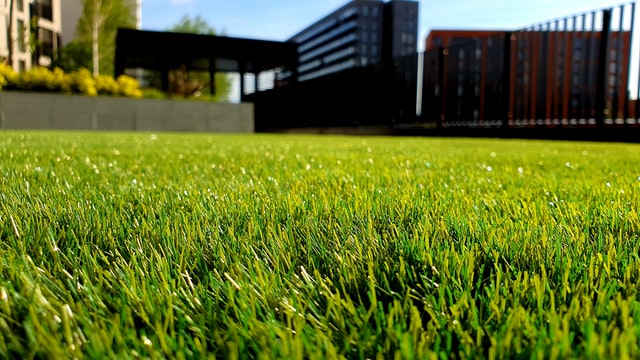Flower gardens are planted and blooming. The vegetable garden is planted and harvesting of lettuces, spinach and other greens has begun. Shrubs and trees have been trimmed from winter and spring wind damage. We’re getting ready for the summer barbeque season and entertaining friends and family in our yard. However, the lawn is not ready. It’s still droopy and spotty. It definitely doesn’t look like a wonderful, green golf course. There is still time to get your lawn in spit spot shape before the hosting season begins.
Do you know the type of grass is in your lawn? When you look for lawn care supplies be sure to get the proper ones for your type of grass. In our area of northern Oklahoma, our warm-season grasses are usually Bermuda grass and possibly some Buffalo grass. These grasses go dormant in the winter and turn beige brown and green up in the spring. If your lawn stays green all winter long or you have shady spots where the grass grows well, you may have cool-season grasses such as Kentucky Bluegrass, Ryegrass or Fescue. Regardless, for treating your lawn in May, the maintenance for warm-season or cool-season grasses are much the same.
Fertilize your grass. Just as new animals and birds born in the spring need to be fed to grow, so does your lawn. A good quality fertilizer contains Nitrogen, Phosphorus, and Potassium. These natural chemicals should be listed on the packaging with their percentage ratio with the suggested area of coverage. Two examples of what you might find on your fertilizer are a 20-5-10 in a 5lb bag. This means it is 20% Nitrogen, 5% Phosphorus, and 10% Potassium and a 5-pound bag will cover an area of 1000 square feet or a 50-foot by 20-foot lawn. A second example is a 10-5-5 in a 10lb bag. This has 10% Nitrogen, 5% Phosphorus and 5% Potassium and is formulated to also cover a 1000 square foot lawn. Notice the bag is twice as large as the previous example. Always follow the directions, as over-fertilizing can kill your grass. The proper fertilizing and watering will establish a deep root system, healthy grass, and a beautiful lawn. Be sure to thoroughly water your lawn as soon as it is fertilized.

Watering your lawn regularly is also important to its health. Check your irrigation system is functioning well with no leaks. Ensure that it is watering uniformly and not wasting water on hard surfaces such as sidewalks, driveways and walls. Deep watering your lawn as determined by need, rather than a set schedule helps establish deep roots, creating a healthy, durable lawn. Determining factors include rainfall, wind, direct sunlight versus cloud cover and temperature. Frequent, light watering and overwatering lead to shallow rooting, soil compaction, thatch accumulation and weed growth – all of which are not attributes of a healthy lawn. If your grass looks a little wilted and has a bluish-gray appearance, it is time to water. Enough water should be applied in one application to wet the soil to a 6-inch depth. You can check this by probing the soil by inserting a screwdriver into the ground. If it goes in easily and comes out with some soil sticking to it, it is pretty well watered. If it is difficult to insert the screwdriver to the proper depth, continue to water. If the water begins to puddle or run-off, stop watering and allow the water to soak into the soil. Then continue watering. Water only in the morning. Watering in the day promotes evaporation and wastes water that plants could otherwise absorb. Watering in the evening allows water to stand, collecting bacteria which lead to rotting your grass.
Proper fertilizing at the beginning of May and watering throughout the spring and summer mornings will help give you a beautiful, healthy, green lawn you can be proud of.
For more tips to a healthy green lawn, check out the Oklahoma State Cooperative Extension website at extension.okstate.edu and click on “Publications” for lawn care fact sheets or contact the Garfield County Extension Office at 580-237-1228.






